
“Marionettes,” episode five of the second season of Netflix’s The Crown, is light on both plot and jewels, unfortunately. But we’ve still got a few interesting things to discuss jewel-wise — and history-wise! (If you need to catch up on previous recaps, they’re all over here!)

We begin in August 1957. The 2nd Baron Altrincham, a writer and journalist who is also an aristocrat, has published a pointed editorial criticizing both the way the palace is run and the Queen herself. He picks on her personality and even her voice (in real life, he actually said that she sounded like “a priggish schoolgirl, captain of the hockey team, a prefect and a recent candidate for Confirmation”), and the press in Britain are selling copies like hotcakes.
The portrait of Elizabeth here features her wearing several pieces of replica jewelry: Queen Mary’s Fringe Tiara (which was then owned by the Queen Mother), the emerald earrings from the Delhi Durbar Parure, and the Godman Necklace (which is a continuity error — the episode takes place in 1957, and the Queen was not given the necklace until 1965).

People can’t stop talking about Altrincham’s “attack” on the Queen, and one man in particular is very upset about it.

He waits outside the ITN television studios, where Altrincham is recording an interview, and gleefully punches him in the face.
(This is real! The man in question, Philip Kinghorn Burbidge, was a member of a far-right organization. He was fined 20 shillings for his crime. According to contemporary news reports, the real Lord Altrincham simply replied, “That was a rather silly thing to do.”)
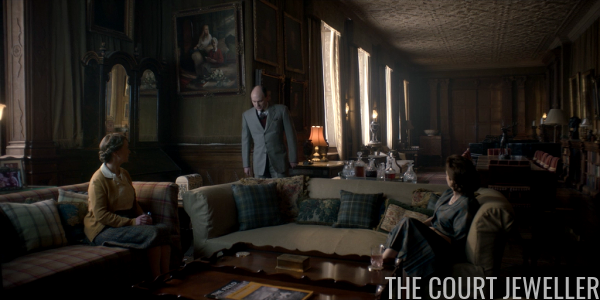
At Balmoral, Michael Adeane tells Elizabeth and the Queen Mother that Altrinchman has been popped in the face — and that he’s going to be on television later that night. Everyone watches nervously.

And then, we head back in time to one month earlier, as Adeane is putting the final touches on a speech that the Queen is due to give at a Jaguar factory. One staffer is worried that the language and tone sound too out of touch, and he goes to Martin Charteris with his concerns.

Bertie Pelham — er, Charteris — goes to Adeane to talk about the speech, but when he gets there, the embodiment of tradition himself, Tommy Lascelles, is already in the office. Martin tells them that he thinks the speech is too paternalistic, but they dismiss his concerns. So we’ve got a clear-cut conflict: half of the courtiers are married to tradition, and half are interested in change.

The Queen, though, trusts Adeane and has accepted his version of the speech without question. While everyone else argues, she’s in the middle of the most entertaining scene of the episode. Her hairdresser attends to the Royal Coif while “Zadok the Priest” plays triumphantly in the background. It’s hilarious.

The stylist goes for a slightly different ‘do for HM, and this is Philip’s face when he sees it on the way to the Jaguar visit. He bluntly tells her that if she really does want more children, the hair isn’t helping.

Elizabeth reads Adeane’s speech, and it’s not good. It’s dismissive of working people, calling their lives “average” and “dreary.” And she’s not even wearing a brooch!

Lord Altrincham hears the speech and brainstorms a response. He’d been looking for content for his magazine, and this critique of the Queen and the institution seems like just the thing.

Following the Jaguar visit, the royals decamp to Balmoral for their summer holiday.

We see the Queen stag hunting, and we find out that she’s a very good shot. Peter Morgan, creator of The Crown and writer of this episode, was also the writer of The Queen. He’s super into narratives that combine public and press criticism, the Queen, and bloodsport, apparently.

Altrincham’s magazine comes out, with the same portrait of the Queen featured at the top of the episode. The editorial was published at the beginning of August 1957.

Elizabeth, wearing pearls, hears about Altrincham’s critique from Adeane.

She discusses it with the Queen Mother, who reminds her that it’s August, the time when people publish all sorts of royal nonsense. (My friend Patricia Treble calls it the “silly season” for the press.) The Queen Mother had every right to be miffed at the real Lord Altrincham’s criticism, too; he wrote, “Like her mother, [the Queen] appears to be unable to string even a few sentences together without a written text — a defect which is particularly regrettable when she can be seen by her audience.”
Notably, Altrincham critiqued several members of the royal family — but wrote absolutely nothing about Prince Philip. Hm.

Altrincham’s comments have gained so much attention that he’s invited on Impact to speak with Robin Day. He claims that he’s just trying to help the monarchy by critiquing it.

The Queens Elizabeth react like this.

The Macmillans don’t seem super thrilled, either.

And neither do the Charterises.

And Tommy and his Irish wolfhounds are having NONE of it.

After the program, Adeane tells the Queen that they’ve learned more about the man who punched Altrincham — that he’s a right-wing extremist who believes in white supremacist causes and wants to defend imperialism. Elizabeth is rightfully disturbed. But she also blames Adeane for the entire mess in the first place — after all, it was his speech, and she trusted him to strike the right tone.
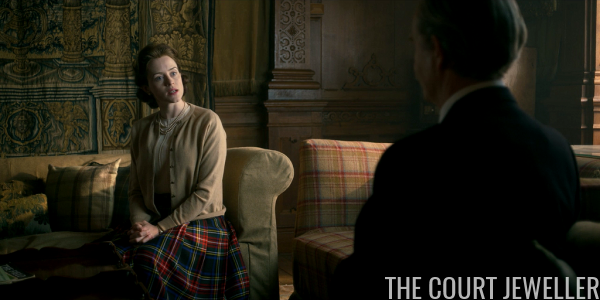
The situation blows up to the point that Macmillan comes to Balmoral for an audience with the pearl- and kilt-clad Queen. He wants her to put out this fire once and for all.
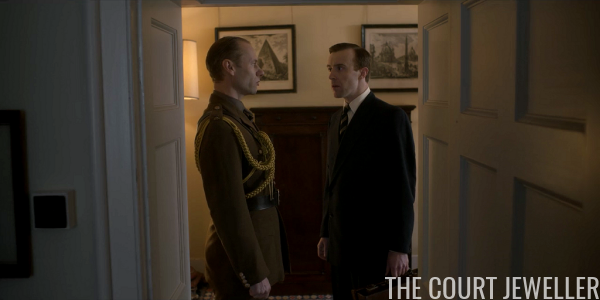
So the palace summons Altrincham for a meeting with Martin Charteris to discuss his ideas for improving things within the monarchy.
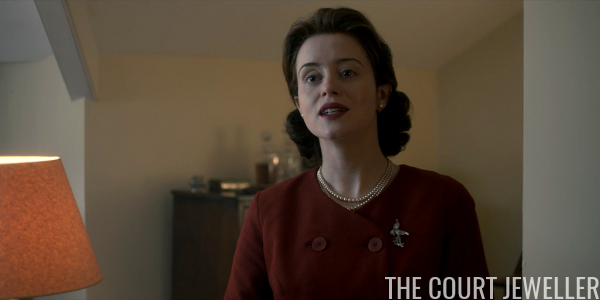
But it’s not Martin Charteris that he meets — it’s the Queen herself, wearing the production’s “bird” brooch. (Altrincham really did meet with Charteris, but this bit about the Queen seems to be an invented moment.) She defensive in the face of his personal critique, but she hears him out, letting him make suggestions that include ending the presentation of debutantes (which was indeed ended in 1958), allowing divorced people to circulate in the royal world, and getting rid of courtiers who resist change.

When the meeting is over, the Queen seems to vanish from the room, almost like a magic trick. Charteris arrives and continues the interaction, warning Altrincham not to tell anyone that he met with HM herself.

One of Altrincham’s suggestions is quickly implemented: televising the annual Christmas message. (This seems to have been in the works before Altrincham ever published his critique.) Elizabeth is not happy about it. She doesn’t like to perform; she feels like “a common little showgirl.” Lots to be said about the intersection of monarchy and performance, for sure.
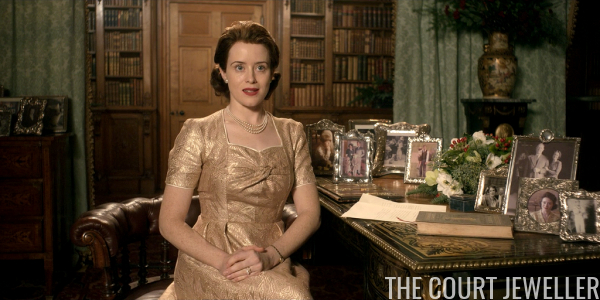
But she carries on and does it anyway. Her costuming here is a fairly careful reproduction of her actual attire for the 1957 Christmas broadcast.

We get a good look here at the pearl button earrings she’s wearing, plus one of her three-stranded pearl necklaces.

In the wings, the Queen Mother (wearing pearl drop earrings and a pearl necklace) sits with Philip to watch the broadcast. Everyone else seems to want change in this episode, but she’s still clinging hard to tradition.

A second suggestion from Altrincham is also implemented: he wanted to see more working people spending time with the royals, and we see the family welcoming guests for a reception at the palace.

Margaret, all clad in her fancy ’50s gold jewelry, watches the arrivals with Prince Philip. He remarks positively on the changes to her hair — all thanks to Tony, of course. (There’s also a weird Vidal Sassoon joke here that falls pretty flat.)

The Queen Mother, in the same pearl earrings and a three-stranded pearl necklace, is downcast as they wait to greet their guests. She feels the old way of doing things completely slipping away.

Elizabeth, also in pearls, isn’t totally happy either, but she seems to understand that change is necessary for survival.

And so they go out to greet their guests. The show follows up with lavish praise for Altrincham, who later disclaimed his peerage and was hailed by some as a savior of the monarchy. Perhaps a little more credit could be given to the woman who actually made it happen, too?
Leave a Reply